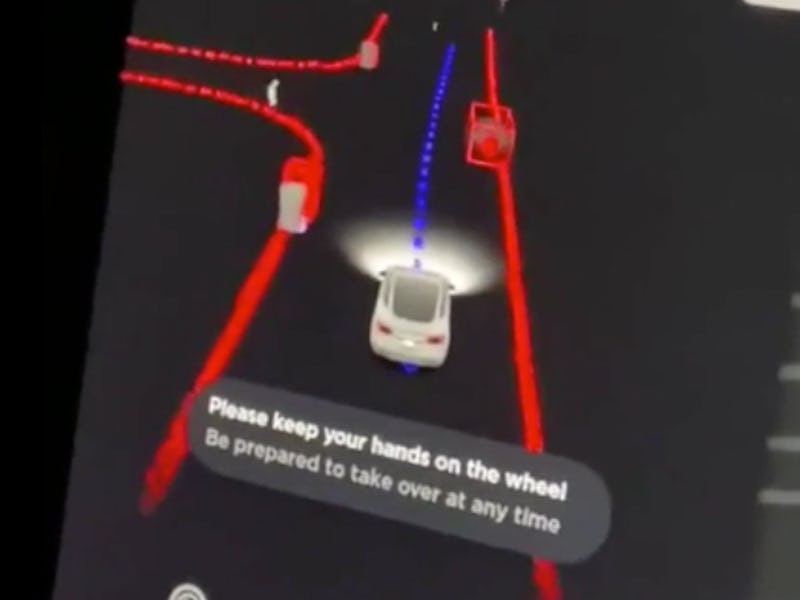Tesla self-driving beta videos reveal what it’s like to ride in a fully autonomous vehicle
Tesla has started rolling out its full self-driving software to a limited group of users, and the results are impressive.

Tesla's full self-driving beta has hit the streets — and the new software is already receiving overwhelming praise from early testers.
CEO Elon Musk announced Tuesday that a beta version of Tesla's highly anticipated new software would be deployed in select cars. And over the past 48 hours, videos have begun to emerge of the system in action.
The so-called "full self-driving" software update promises to steer a Tesla car autonomously in selected situations — but only on the understanding the driver pays full attention in case they need to take over.
"Elon, you madman!" YouTuber and Tesla fan "Tesla Raj" said during his first hands-on test of the update.
The release is a big step toward fulfilling Musk's ambitions for fully autonomous driving. Since October 2016, Tesla vehicles have shipped equipped with the cameras and sensors needed to enable fully autonomous driving — all they need is the right software update.
While Tesla competitors like Waymo have used depth-sensing lidar to assist their autonomous systems, Tesla has instead tried to improve on its computer vision software. During the company's third-quarter 2020 earnings call Wednesday, Musk declared the firm wouldn't add lidar "even if it was free."
The update has been slow to roll out. Tesla missed its own target of completing a cross-country autonomous road trip by the end of 2017. This month, Musk explained the company had "barked up" the wrong tree "for way too long" by trying to develop a system similar to that of Waymo. Tesla's new beta has been described as a major rewrite of its existing semi-autonomous driving software.
The early beta has certainly impressed at least some of lucky fans who were able to test it:
As shared by the Twitter account "TeslaownersSV," the release notes read:
"Full Self-Driving is in early limited access Beta and must be used with additional caution. It may do the wrong thing at the worst time, so you must always keep your hands on the wheel and pay extra attention to the road. Do not become complacent."
The notes also outline the software's intended features:
"When Full Self-Driving is enabled your vehicle will make lane changes off highway, select forks to follow your navigation route, navigate around other vehicles and objects, and make left and right turns. Use Full Self-Driving in limited Beta only if you will pay constant attention to the road, and be prepared to act immediately, especially around blind corners, crossing intersections, and in narrow driving situations."
Twitter user "brandonee916" was also able to capture footage of the street, while also looking at the road:
Twitter user "Driveteslaca" was also able to show how the software handles turns:
Musk has big plans for the full self-driving features. During the company's third-quarter 2020 earnings call Wednesday, Musk explained how Tesla wants to offer an Uber-like robo-taxi feature, enabling passengers to hail autonomous cars with their phone. Families and friends could also share a single car between themselves.
Tesla owners interested in getting their hands on the new features will have to act fast — prices in the United States are expected to increase by about $2,000 on Monday. That means the upgrade is likely to cost around $10,000.
The Inverse analysis – The self-driving features seem impressive, but it will be interesting to see how people use it over time – and whether they abide by Tesla's warning to always keep their hands on the wheel. A Tesla owner in Canada was charged with dangerous driving last month after being accused of sleeping while the semi-autonomous Autopilot software drove the car.
In July, Tesla's marketing of Autopilot came under legal scrutiny. A German court ruled that "by using the term 'autopilot' and other wording, the defendant suggests that their vehicles are technically able to drive completely autonomously." Musk criticized the ruling on Twitter by writing that "Tesla Autopilot was literally named after the term used in aviation."
These disputes set the tone for any future fight to get the company's robo-taxi service approved. Tesla will need to convince regulators that its Uber-like service is safe enough to operate without a driver.
On the road to full autonomy, the software may be just the beginning.